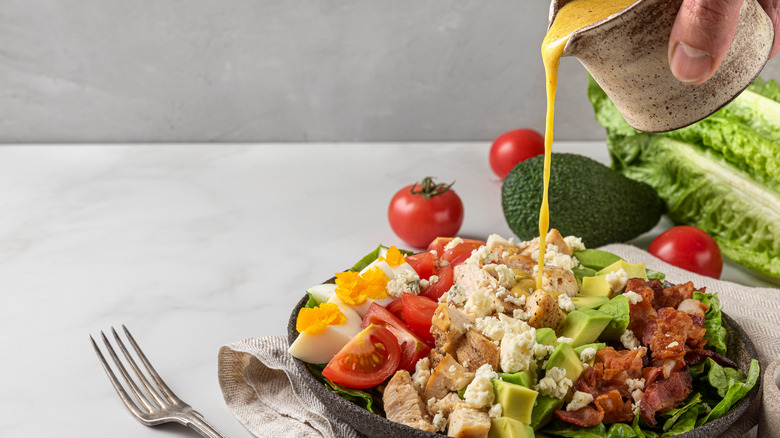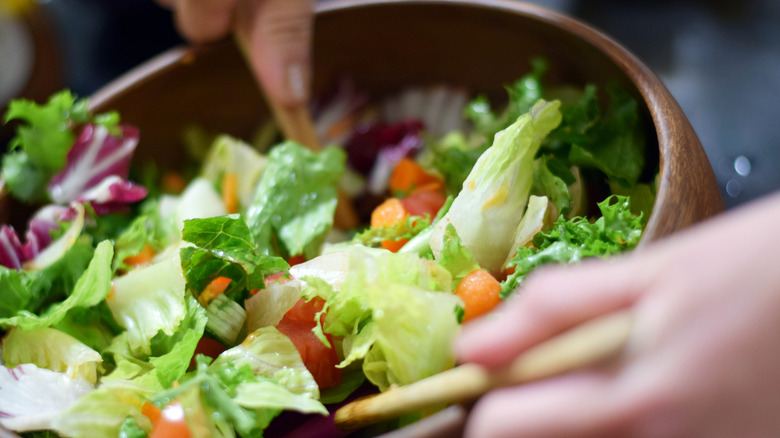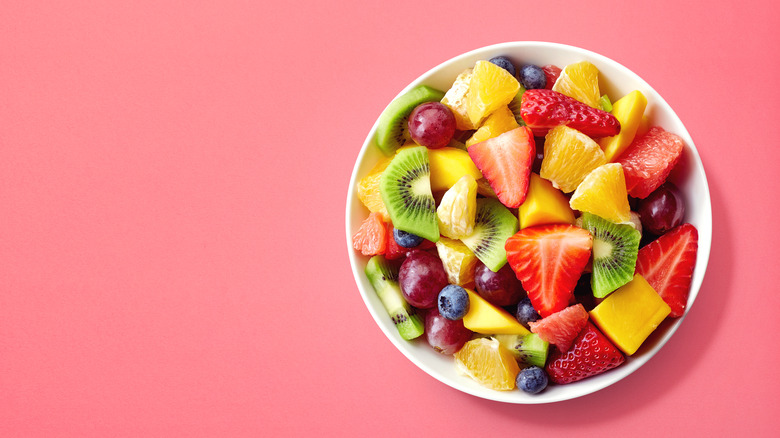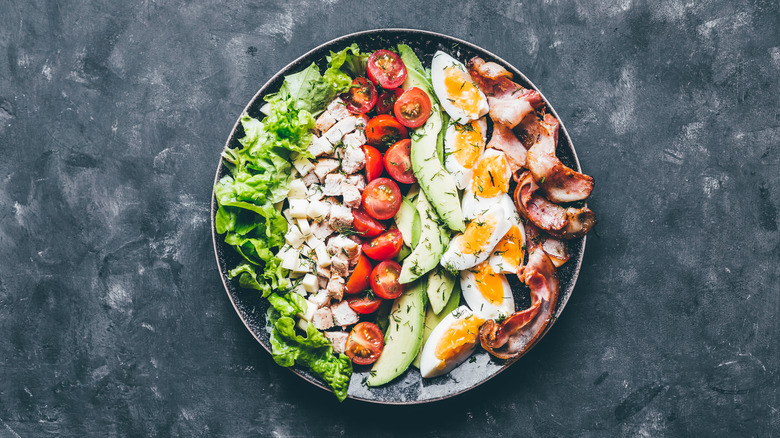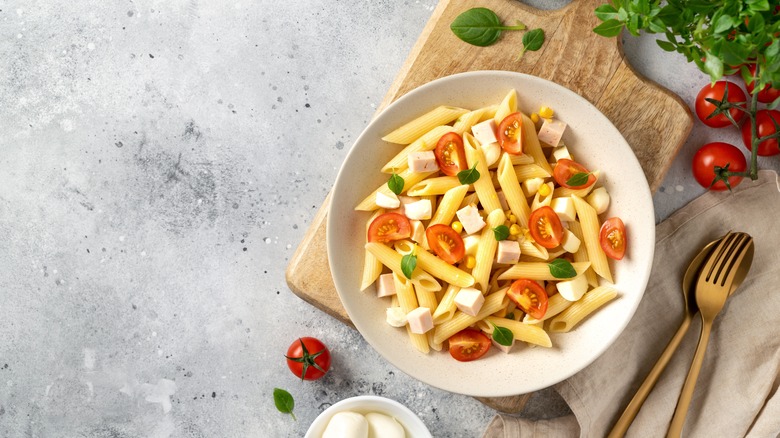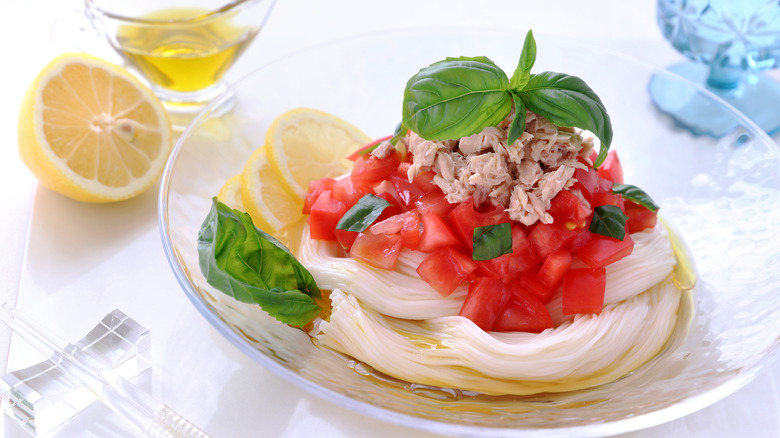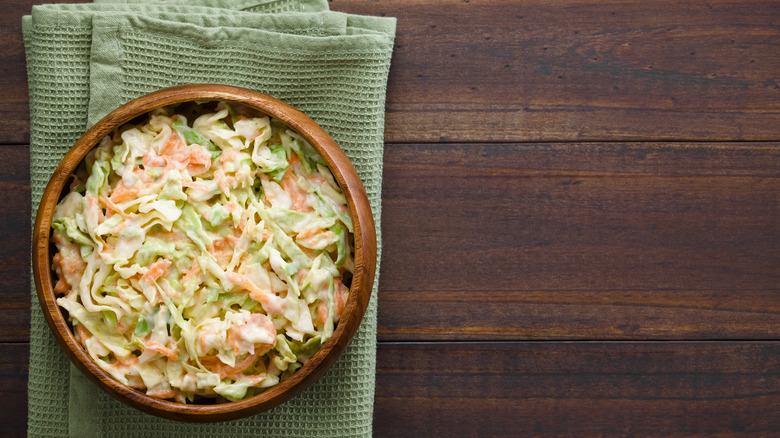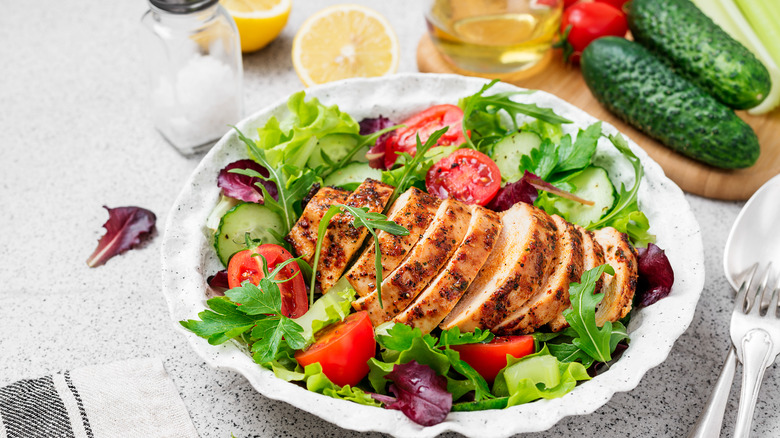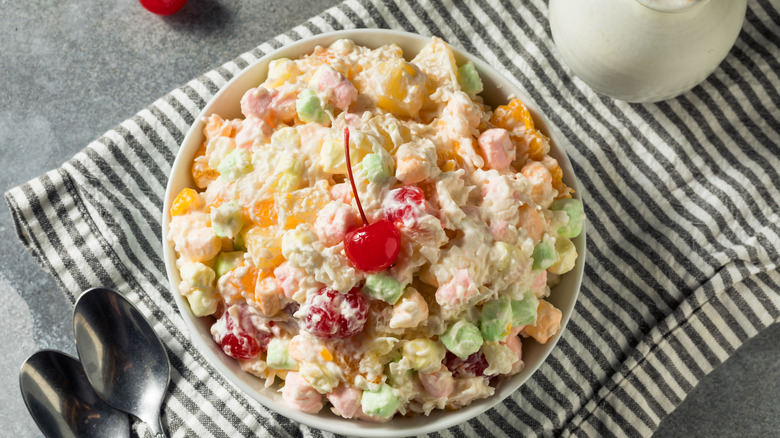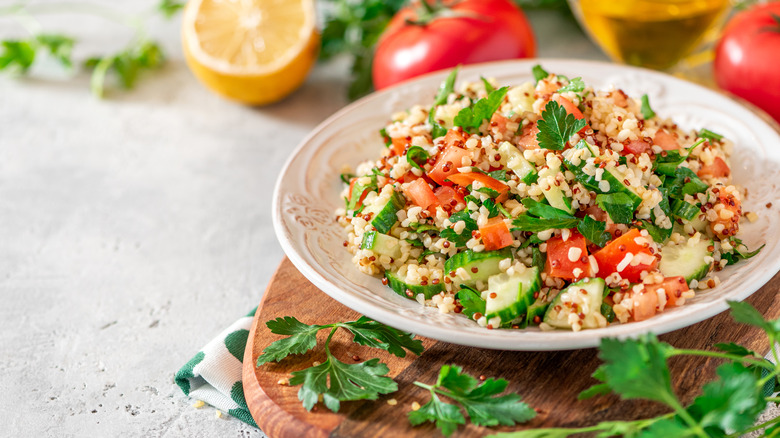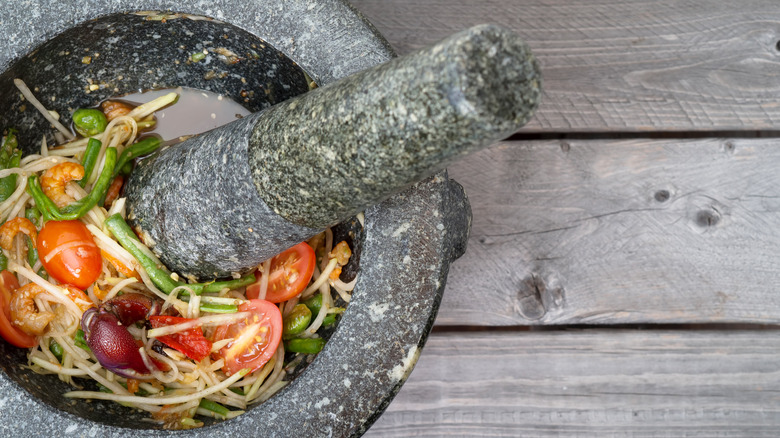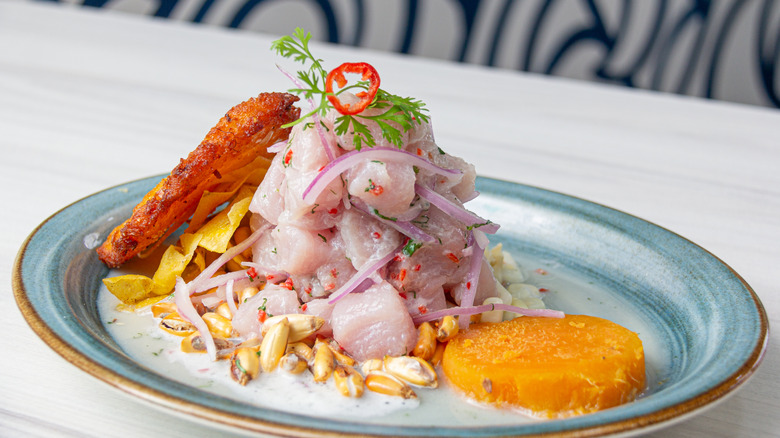Types Of Salad Categories, Explained
The Merriam-Webster Dictionary defines a salad as "any various cold dish" in which either raw greens or small pieces of food are tossed with vegetables, and toppings, and served with dressing. But that doesn't stop food media gurus like Dan Pashman from The Sporkful and author J. Kenji Lopez-Alt from arguing if pasta salad should be given the proud distinction of a "salad."
The sheer variety in salad types and personal reservations about mayonnaise always keep us guessing how far we can go to call a dish a "salad." In the hope of providing clarity to this question, we have completed some of the legwork to group salad types together based on important shared characteristics, ingredients, and preparation methods. Some of the foods we've grouped into categories are not mutually exclusive. For example, potato salad is both a bound salad and a side salad. Regardless of the type of salad, we should note that all of the salad types are good salads (unless you're talking about lime Jello salad — to which we wholeheartedly disagree).
Tossed salad
A tossed salad is defined as any salad made with greens and at least one other ingredient (which can include tomatoes, cheese, peppers, and alike), tossed in an oil-based dressing, according to the Merriam-Webster Dictionary. This definition is broad — and distinct from the composed salad with more specific assembly directions than just "toss." Your favorite Caesar dressing made with chopped romaine, parmesan, croutons, and creamy dressing is just as much of a tossed salad as a fattoush salad made with lettuce, radishes, pomegranate seeds, chopped pita chips, and finished with a pomegranate vinaigrette.
According to Anna's House, the tossed salad became increasingly popular with advanced lettuce cultivation methods in the late 1800s. Ice shipping methods expanded access to markets in the Western United States. The Agricultural Marketing Resource Center estimates that one-quarter of all iceberg lettuce in the United States goes toward prepackaged tossed salads sold in grocery stores across the nation.
Fruit salad
Fruit salads are a versatile food for folks who wholeheartedly despise eating vegetables. These versatile salads can include almost any type of fruit. Some fruit salads allow the fruit flavors to shine through, while others utilize a vinaigrette or maceration to keep the fruit fresh and amplify flavors. Food personality Geoffrey Zakarian recommends being strategic about the placement of the fruit salad; soft fruits like bananas and berries should be placed on top to prevent squishing. Zakarian also recommends adding an acid, like orange juice, to the top of the salad to prevent the fruits from oxidizing and turning brown. Berries and bananas should also be added to the salad before serving because the fruit does not tend to hold up as well as grapes, melons, and other fruits.
The oldest type of fruit salad, originating in 17th century France, is compote. According to the South Florida Reporter, compote is French for "mixture" made by boiling fruit, water, sugar, and citrus slices. The compote is left chunky and can be served warm or cold; coulis is smoother than its compote cousin. Both coulis and compote were served with sour cream and biscuits during afternoon tea. During the Renaissance, compote was chilled and served with dessert.
Composed salad
The composed salad is a methodically-organized, neat salad type that isn't normally tossed or disturbed. One of the first members of this category is the Cobb salad — created in 1937 by Bob Cobb. Per the Institute of Culinary Education, Cobb pulled out the remnants of his Hollywood restaurant's refrigerator, including boiled eggs, cheese, avocado, chives, lettuce, and tomato, and fixed the ingredients into a salad. The key to making a great Cobb salad? The institute recommends dressing each ingredient individually and serving an ovular container rather than a round container for better toping distribution.
The wedge salad is also classified as a composed salad. According to Hitchcock Farms, the wedge salad was first featured in a 1916 cookbook entitled "Salads, Sandwiches and Chafing Dish Recipes." In the 1970s, more steakhouses started putting individual spins on the wedge salad to include new dressings and vinaigrettes. Although there might not be a specific recipe for the wedge salad, per-say, there is a recommendation on how to eat the wedge salad to avoid embarrassing yourself when you can't put a whole wedge in your mouth at once. It's important to chop the wedge with a knife and fork, dab in dressings and toppings, and enjoy.
Pasta salad
According to Culinary Debates, the pasta salad is made from cold pasta, meats, seasonings, vegetables, and a dressing. Although macaroni salad is technically a pasta salad because it is made with wheat-based pasta, it would also be considered bound because it is bound to other ingredients with mayonnaise rather than the traditional pasta salad dressing of Italian dressing or oil. Regardless of the other ingredients you choose to add to your pasta salad, we recommend using fusilli (corkscrew) pasta. It's the absolute best pasta shape to use because of its surface area. The flavors stick to the edges of the pasta rather than falling to the bottom of the bowl. When cooked, the fusilli retains its shape and looks great in a bowl with other veggies, cheeses, and meats.
Pasta salad is customizable based on the desired flavor and texture. Ditch the salami and Italian cheeses for a Southwest pasta salad made with sour cream and mayonnaise dressing, corn, beans, avocado, and grape tomatoes.
Noodle salads
Although it is instinctive to place pasta salad and noodle salads into the same category, the two vary in preparation and serving methods. Noodles can include ingredients beyond wheat products like soba (buckwheat), vermicelli (rice), or glass (mung bean) noodles. Soba noodles are one of the most popular noodles to be used in salads; you can cool and dress the noodles with soy sauce and Asian vegetables. You can also integrate flavors from outside of Eastern Asia to include tahini and avocado in a soba salad.
Somen salad is a light, delicious Japanese salad served warm or chilled with thin wheat-based somen noodles, lettuce, spam, eggs, kamaboko (cured white fish pureed into a paste), carrot, cucumber, and green onions. The salad is usually dressed with a vinegar-based sauce, according to Keeping it Relle, made with shoyu for a distinctly Asian flavor. The salad comes together in less than 15 minutes and is perfect for lunch.
Bound salad
Bound salad is made by combining ingredients together with a binding agent, like mayonnaise, a boiled dressing, or the dreaded Miracle Whip, per Cook's Info. This recipe includes everything from chicken salad and tuna salad to Waldorf salad: a salad made from celery, walnuts, and fresh apples tossed in mayonnaise served over a bed of lettuce. Bounded salads can also include sweet, dessert salads like ambrosia: made with maraschino cherries, mandarin oranges, and marshmallows, and swallowed up in a glop of yogurt or whipped topping.
There are some downsides to consuming mayonnaise-based salads (besides the flavor), though. Eating raw eggs can increase the risk of exposure to salmonella. Leaving mayonnaise-based salads out on the picnic table at a summer barbecue can increase the risk of exposure to food-borne pathogens. The CDC recommends capping the time that mayonnaise-based salad is at room temperature for two hours. If the temperature is more than 90 F, the time should be shortened to no more than one hour.
Appetizer salad
The appetizer salad is served as a precursor to the main entree of a meal. Antipasto salad is an appetizer salad that can include a small portion of cooked pasta with cheese, olives, tomato, and artichokes. You might also find a light, fresh plate of Caprese salad with heirloom tomatoes, mozzarella, basil, and a fresh drizzle of extra virgin olive oil and balsamic.
Hippocrates was one of the earliest recorded proponents of the appetizer salad. Per Anna's House, the Greek physician believed eating raw vegetables before the main course helped clear the stomach and intestines of blockages; this would in turn aid in the digestion of the main course. At the time, critics of Hippocrates' theory believed that the flavor of vinegar in the dressing would obscure the flavor of the wine eaten during the main course. But, hunger trumped taste, and the appetizer salad was popularized ever since.
Side salad
Side salads are not typically the entirety of a meal; it's usually served as an accompaniment to the main course. Coleslaw is an example of a side salad made from shredded leafy vegetables (usually cabbage), salt, and a dressing. You can make variations on the recipe to use a mayonnaise dressing instead of vinegar, or include other ingredients for a unique crunch.
Coleslaw isn't the only side salad you'll see at a barbecue; you can also drop a spoonful of potato salad on your plate for a filling side dish. Potato salad can be modified based on your favorite ingredients and textures; we recommend adding a scant amount of curry to your next potato salad for an unforeseen spicy kick. You can also integrate Dijon mustard, jalapeños, dill, or cumin into your next potato salad recipe instead of the basic mix of boiled potatoes, mayonnaise, mustard, and pickle relish.
Main course salad
If you tend to eat light when you go out to eat at a restaurant, you've probably found yourself asking if the salads on the menu are "dinner salads" or just appetizers. Unlike lighter appetizer salads, the dinner salad typically contains protein and a slightly larger portion of lettuce and greens. According to Nutrition for Fit, adding protein to your salad is important for keeping the body more full than just eating a bowl of veggies. The protein is also important in creating chemical building blocks in the body.
Along with protein, consider adding fat to your main course salad. The Heart and Stroke Foundation of Canada recommends replacing saturated fats with ones like avocado, almonds, and other nuts, and dressings made from olive oil, nuts, or seeds. A salad filled with all of your essential macronutrients is a great way to rejuvenate you and keep your body full.
Dessert salad
If you live by the philosophy of "save room for dessert," you may not think about eating a salad after a savory dinner. But salads can indeed be a good way to go and get a dessert in. Besides ambrosia salad, you'll find Watergate salad in the lexicon of dessert salads. This green goop originated in the 1970s and is made from pineapple, chopped pecans, marshmallows, and whipped cream combined in a green goop of pistachio pudding.
Watergates were popularized by another classic, yet controversial, American dessert: Jello. According to America's Test Kitchen, jello salad can come in numerous sizes, shapes, and flavors. You'll see strawberry jello studded with fruit and whipped cream or a bowl of lemon jello with a plop of Cool Whip on top. If you can withstand the sweet versions of Jello salad, we can't promise you can stomach a lime Jello and cheese salad, per Antique Trader, made by encasing cottage cheese, onion, and lime Jello in a bundt mold and topping with seafood salad.
Grain salad
Grain salads are a popular lunch option at Mediterranean restaurants. You can find almost any common grain, including farro, quinoa, and rice in a salad, as well as more unconventional grains like cracked barley and freekeh. Tabbouleh is an example of a grain salad made with bulgur wheat; this Mediterranean side salad includes the fresh flavors of parsley, mint, tomatoes, onions, and cucumber.
Rice salad has variations based on region. The New York Times notes that Roman Italians make rice salad using pickled vegetables, capers, tomatoes, and tuna. In Spain, you'll find ensalada de arroz made with tuna, peppers, olives, and occasionally mayonnaise. The Spanish version can be eaten on its own or served in small piquillo peppers for tapas. Regardless of the region, there are standard ground rules for using rice in a salad. The first, using fresh rice rather than day-old rice. Unlike pilaf or other rice dishes, the rice for rice salad is boiled like pasta. After the rice is cooked in a pot with salt water, it is drained and cooled on a plate before being incorporated into a salad.
Bean salad
The concept behind bean salad is relatively self-explanatory. One of the most common versions, three-bean salad, is made with kidney, wax, and green beans mixed with chopped onion and pepper, per Quaint Cooking. The salad is then marinated in a sweetened vinaigrette dressing. Occasionally, cooks add a fourth bean, the chickpea, to the salad. The three-bean salad was popularized in the 1950s for its ability to withstand warm summer temperatures, unlike other mayonnaise-based salads.
Other popular bean salads include cowboy caviar, which is another name for the Mexican-originated pico de gallo: a mix of black beans, black-eyed peas, corn, tomato, avocado, onion, pepper, and a citrus oil dressing. Pico de gallo is the perfect refreshing dip for a party and can be eaten from a bowl or atop a crisp tortilla chip. You can also get creative and add your favorite spices to the salad for more heat. If you're feeling inspired by pico de gallo but don't want to do a DIY recipe, pick a jar up during your next Trader Joe's trip.
Pounded salad
Pounded salad is a relatively novel and specific salad type. According to Saveur, Northern Thai chefs will occasionally bruise salad ingredients before adding the fruits, vegetables, and spices to the salad. This mechanical alteration can cause the ingredients to become more aromatic and fragrant. One example of a pounded salad is tam khanun, a spicy raw jackfruit salad made with a pounded curry paste of chili, garlic, shallots, pickled fish, lemongrass, and other aromatics, (via Thai Food Heritage). Som Tham Thai, a pounded papaya salad, was recently popularized in America with Chrissy Teigen's "Cravings" cookbook, per Food Republic. The chili, garlic, and sugar are pounded before being mixed with fish sauce and fresh lime juice. This dressing coats green papaya slices (or green beans, depending on the recipe) and is served with warm rice and a chopped peanut garnish.
One example of a pounded salad from outside Thailand is the Japanese pounded cucumber salad (shojin ryori). This salad is made by mashing a cucumber with a kitchen knife or rolling pin before adding a spicy chili, sesame, and vinegar marinade.
Seafood salad
We have decided to award the seafood salad a category of its own. While the Americanized seafood salad includes imitation crab meat and raw shrimp in a dill-mayonnaise dressing, per Dinner at the Zoo, other regions of the world have adapted seafood salad to fit the local catch and local palates. Ceviche, for example, is a South American appetizer made with skinless, sushi-grade fish (typically halibut, snapper, or bass) with lime juice, vinegar, onion, pepper, cucumber, and cilantro. Ceviche is meant to be a light starter, and these ingredients are nothing less than fresh.
Ina Garten's Italian-inspired seafood salad is made from a variety of seafood species including shrimp, sea scallops, and mussels (via the Food Network). The protein is blanched slightly to kill lingering pathogens, but not overcooked to disrupt the fresh-from-the-sea texture of the seafood. The seafood is dressed with a mixture of limoncello, plum tomatoes, fennel, lemon juice and zest, and fresh Italian herbs.
